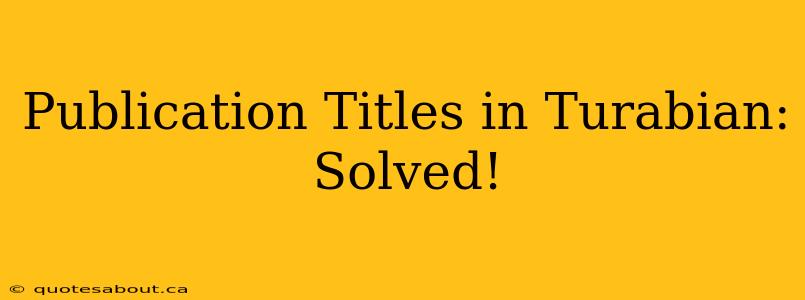The Turabian style, a widely used citation system, can sometimes seem daunting, especially when it comes to formatting publication titles. This guide will clarify the rules for handling titles of books, articles, journals, and other publications within your Turabian-formatted papers. Understanding these rules will not only help you avoid frustrating formatting errors but also ensure your work maintains academic rigor and professionalism.
What are the Basic Rules for Titles in Turabian?
The core principle guiding Turabian's treatment of titles is consistency and clarity. The style distinguishes between titles of larger works (like books and journals) and smaller works (like articles and chapters).
-
Larger Works (Books, Journals, Websites): These titles are italicized. Think of it as signaling importance; these are the overarching containers holding smaller works.
-
Smaller Works (Articles, Chapters, Webpages): These titles are placed in quotation marks. They are contained within the larger works.
Let's illustrate with examples:
-
Correct: The Chicago Manual of Style provides guidance on citation styles.
-
Incorrect: "The Chicago Manual of Style" provides guidance on citation styles.
-
Correct: I consulted the article "Turabian Citation Style: A Quick Guide" for formatting help.
-
Incorrect: I consulted the article Turabian Citation Style: A Quick Guide for formatting help.
How Do I Handle Titles with Subtitles?
Subtitles are an integral part of the title and should be included. For larger works, both the main title and subtitle are italicized. For smaller works, both the main title and subtitle are enclosed in quotation marks.
- Example (Larger Work): The Elements of Style: A Guide to Clear Writing
- Example (Smaller Work): "Effective Strategies for Citing Sources: A Practical Guide for Students"
What About Titles in Different Languages?
Turabian generally maintains the original language of the title. However, if your paper is in English and you are citing a non-English work, you may provide an English translation in parentheses immediately following the original title. This enhances readability for your audience.
- Example: La Belle Époque: Une Étude Historique (The Beautiful Era: A Historical Study)
What about Titles within Titles?
This scenario often arises when citing an article within a journal, or a chapter within a book. Maintain the hierarchy: italicize the larger work's title and enclose the smaller work's title in quotation marks.
- Example: “The Impact of Social Media on Political Discourse,” Journal of Communication Studies, 45, no. 2 (2024): 120-145.
How to Handle Titles in Different Publication Types?
Let's break down title formatting for specific publication types:
H2: Books
Titles of books are always italicized. This includes monographs, edited collections, and anthologies.
H2: Journal Articles
Article titles are in quotation marks, while the journal title itself is italicized.
H2: Website Articles or Pages
Website page titles are in quotation marks. The website's name itself may or may not be italicized depending on the context and if it's considered a significant publication (similar to a journal). It's best to consult the latest edition of the Chicago Manual of Style for the most up-to-date guidance.
H2: Conference Papers
The title of a conference paper is usually in quotation marks, with the conference name typically italicized (or treated as a larger work if significant).
H2: Government Documents
Titles of government publications follow the same rules as other publications: italicize for larger works and use quotation marks for smaller works within larger works.
Conclusion
Mastering Turabian's rules for publication titles is crucial for academic writing. By consistently applying the guidelines outlined above, you'll ensure your citations are accurate, professional, and easy to understand. Remember, consistency is key. Always refer to the current edition of The Chicago Manual of Style for the most definitive guidance.

